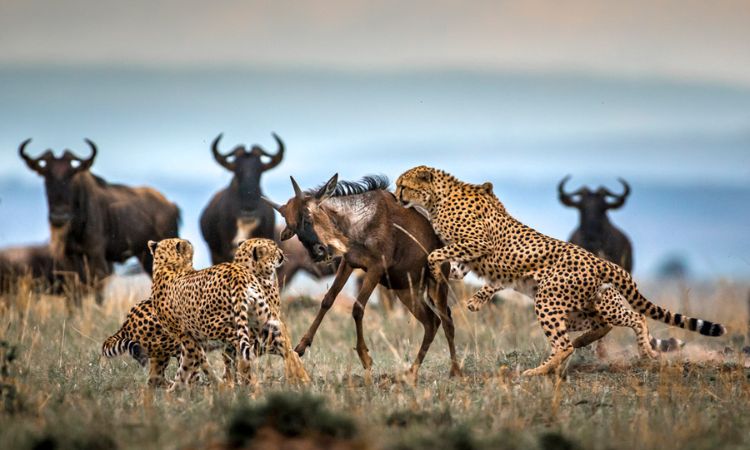Embark on an unforgettable adventure through Kenya’s majestic landscapes and diverse wildlife at Tsavo, Maasai Mara, and Amboseli National Parks. Discover the unique features that make each park a must-visit for safari enthusiasts, offering an immersive experience into Africa’s natural beauty and rich biodiversity.
The Allure of Tsavo National Park
The vast Tsavo National Park is a paradise for wildlife enthusiasts, covering over 22,000 square kilometers of diverse landscapes. It is home to large herds of elephants, the famous Tsavo lions, the stunning Yatta Plateau, and the mesmerizing Lugard Falls. Explore its rich history and ecological significance, as well as the thrilling archeological finds that provide insights into early human habits and trade networks.
The Maasai Mara is renowned for the Great Migration, a phenomenal event where millions of wildebeests, zebras, and gazelles migrate between Tanzania’s Serengeti and the Mara. Learn about its critical role in the ecosystem, the Mara River crossings that draw tourists globally, and the Maasai people’s ancient connection to this landscape. Witness the intertwined pathways of modern conservation and local traditions in this UNESCO-listed reserve.
The Magic of the Great Migration in Maasai Mara
The vast Tsavo National Park is a paradise for wildlife enthusiasts, covering over 22,000 square kilometers of diverse landscapes. It is home to large herds of elephants, the famous Tsavo lions, the stunning Yatta Plateau, and the mesmerizing Lugard Falls. Explore its rich history and ecological significance, as well as the thrilling archeological finds that provide insights into early human habits and trade networks.
The Maasai Mara is renowned for the Great Migration, a phenomenal event where millions of wildebeests, zebras, and gazelles migrate between Tanzania’s Serengeti and the Mara. Learn about its critical role in the ecosystem, the Mara River crossings that draw tourists globally, and the Maasai people’s ancient connection to this landscape. Witness the intertwined pathways of modern conservation and local traditions in this UNESCO-listed reserve.
Amboseli National Park offers awe-inspiring views of Mount Kilimanjaro and exceptional elephant sightings, famously studied by researchers like Cynthia Moss. Understand the importance of this park in elephant preservation, home to over 400 species of birds and other remarkable wildlife. Delve into the park’s historical transitions from Maasai land to a bustling conservation arena filled with life.
Amboseli’s Elephant Observation
Amboseli National Park offers awe-inspiring views of Mount Kilimanjaro and exceptional elephant sightings, famously studied by researchers like Cynthia Moss. Understand the importance of this park in elephant preservation, home to over 400 species of birds and other remarkable wildlife. Delve into the park’s historical transitions from Maasai land to a bustling conservation arena filled with life.
Conservation Efforts and Challenges
Exploring Africa’s Top Safari Destinations involves a deep dive into the heart of Kenya’s wild heritage, where the majestic beauty of Tsavo National Park, the vast, teeming plains of Masai Mara National Park, and the iconic views of Mount Kilimanjaro from Amboseli National Park capture the essence of a truly African safari adventure.
Following the awe-inspiring elephant observations in Amboseli, the narrative transitions into a discussion on the intricacies of conservation within these treasured parks. Tsavo, Masai Mara, and Amboseli face significant conservation challenges, including human-wildlife conflict, climate change, and habitat loss. These issues threaten the very essence of Kenya’s wild heritage, prompting innovative efforts to safeguard biodiversity.
In response to these challenges, a variety of initiatives have been launched. These range from engaging local communities in conservation activities, which not only helps to preserve their heritage but also empowers them through eco-tourism, to international collaborations that aim at promoting sustainable tourism while protecting wildlife. One such innovative approach is the use of technology to mitigate human-wildlife conflicts and to monitor wildlife movements and health, ensuring early intervention when necessary.
Moreover, these parks have embraced adaptive management strategies to combat the impacts of climate change. Efforts such as reforestation and the creation of wildlife corridors aim to counter habitat loss and maintain ecosystem balance. By involving local communities in these activities, conservationists hope to forge a lasting connection between the people and their natural heritage, ensuring that they benefit from the preservation efforts.
As we transition from the challenges and responses in conservation to experiencing Kenya’s safari adventures, it’s crucial to acknowledge the role of sustainable tourism. Travelers are encouraged to embrace responsible travel practices that support conservation efforts, thereby ensuring that Kenya’s parks continue to thrive as havens of biodiversity and cultural heritage. This seamless journey from understanding the pivotal role of parks in conservation to actively participating in their preservation through responsible tourism encapsulates the essence of exploring Africa’s top safari destinations.
Experiencing Kenya’s Safari Adventures
Discover the best ways to experience the enchanting safari tours offered in Kenya’s premier parks. From guided tours to luxury accommodations and cultural interactions with the Maasai, this chapter provides practical tips for the adventurous traveler. Embrace Kenya’s beauty through responsible travel that leaves a positive impact on its landscapes and communities. Explore the magical Tsavo National Park, the sprawling savannahs of Masai Mara National Park, and the iconic views of Amboseli National Park through eyes that seek to preserve their beauty for generations to come.
Conclusions
Exploring Tsavo, Maasai Mara, and Amboseli National Parks offers insight into Kenya’s natural wonders and cultural riches. These parks not only safeguard incredible wildlife and spectacular scenery but also highlight the importance of conservation. With responsible tourism, visitors can enjoy and contribute to preserving these treasures for future generations, participating in Kenya’s ongoing narrative of nature and heritage.




